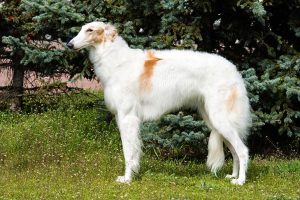
The conditions of the nature and economy in Russia give significant impacts on a few aspects including the types of dog bred in the country. The old Russia and Soviet regime needed working dogs more than lapdogs to be used as guards, herders, and partners for the authorities that could also endure the extreme cold weather. This is why most of the dog breeds native to Russia are from the larger, heavy-duty ones like the Moscow Watchdogs which looks very much like St. Bernard, the East Siberian Laika – a natural hunting dog and also sled-puller, the Siberian Husky that could pull heavy baggage for a long distance even in minus temperature, the East European Shepherd, the Caucasian Sheepdog also known as Caucasian Ovcharka, the Samoyed, and the Russian Black Terrier that was developed under the order of Stalin to guard prisoners.
All of the native Russian dogs above have common looks of, well, dogs. But there is one Russian dog that is very unique in appearance, called Borzoi (Borzaya) or the Russian wolfhound. The long legs, sleek body and slim head give it a majestic, unparalleled look that would turn heads. Just like the name, Borzoi is a dog to hunt wolves with and here are 5 facts about it.
1. Borzoi was an aristocratic dog
In the 17th century, Arabian greyhounds were taken to Russia to aid the dukes and their hunting activity. They were proven to be fast, but couldn’t handle the Russian extremely cold winters. This fact then forced adjustments to be made; the Arabian greyhounds were cross-bred with Russian Laika or sheepdogs to get thicker coat that would help them during the cold months. There were said to be more than just Russian Laika that got paired with the greyhounds to get the best quality of hunting dogs.
Hunting was only done by the Tsars at that time; therefore Borzoi was exclusive only for the upper class and couldn’t be bred or found outside of the designated estate. Finding the best kind of Borzoi was ceremonious for the Tsars as they would take them to hunt for days to select which ones of the pack could bring down big games. These Borzois were then the ones that continue to reproduce. After the 1917 revolution, wolf hunting using the dogs was going down because it was seen as ineffective and time-consuming.
2. When Borzois don’t go to work, they become decoration
During the Soviet time, importing Borzois from Russia was not possible. But today, they can be found in England, Scandinavia, America and Western Europe to be bred as well. Since hunting is no more a common activity for a pastime, especially hunting wolves, Borzois are kept at homes as beautiful pets. Their slim and sleek bodies with silky fur never fail to uplift the appearance of a room. Borzois have appeared in many paintings and work of literature including Leo Tolstoy’s famous novel War and Peace where a wolf hunting scene was pictured. In 2004, an exhibition titled “The Borzoi in Art” was held by the UK Kennel Club to showcase the appearances of the breed in art throughout the 19th and 20th centuries including paintings, bronzes and porcelain that previously were not for the public eyes.
3. Borzoi is prone to gastric issue
The life span of a Borzoi is around 10 to 12 years. Generally, Borzois are healthy and fit dogs both in their youth and old days that most of them get to live long lives. Early deaths were recorded to be caused by cancer and heart problems. When you look at a Borzoi, you could instantly tell that is a deep-chested kind of breed and the most common health problem for this type of dog is gastric dilatation volvulus or commonly known as bloat. This issue must not be overlooked as it could be life threatening for Borzois and could be prevented by taking care of the diet and their position while having the meals. Borzois are quite intolerant to dry kibbles with high concentration that it is advised to feed them raw or oats and table scraps.
4. Borzoi is quite catlike
Though the nature of a Borzoi is hunting dog, which means it should be able to be trained, directed and follow orders, you can’t force it around. Borzoi can be quite stubborn and too dignified to be told to do things the rough ways – very much like a cat. Just by looking at the way a Borzoi stand one can tell that it is a regal dog that has its own ways. Borzois are quiet, gentle, reserved and sensitive dogs that don’t bark much but have natural respect for humans. They can get nervous around strangers but are very affectionate with people they know well. It takes a lot of patience to raise Borzois because of their unique personality. They don’t like boring, repetitive and useless activities but are eager to jump into competitions as they motivate Borzois and they know the goals. This is why the breed is popular for dog race just like with most hound dogs.
5. Borzois are big
It takes big, fast and tough dogs to hunt and especially take wolves down. Borzois meet these points very well. An adult male Borzoi could stand as tall as 85 centimeters at the shoulder with weight around 45 kilograms, while the adult female is around 66 centimeters tall at the shoulder and weighs around 33 kilograms. The coat is long around the neck and body but thin around the legs that emphasizes the elegance and length of them.
Those were the 5 facts about Borzoi, a Russian dog famous for wolf-hunting and race. Despite its popularity, Borzoi is not a type of dog everyone can afford to own. Just like a lot of beautiful things in the world, they exist just to be admired.
